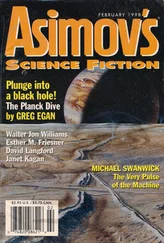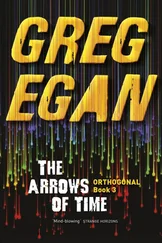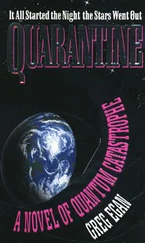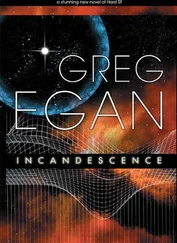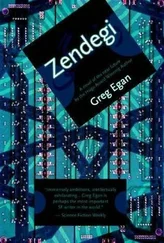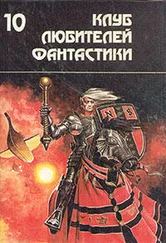Greg Egan - The Eternal Flame
Здесь есть возможность читать онлайн «Greg Egan - The Eternal Flame» весь текст электронной книги совершенно бесплатно (целиком полную версию без сокращений). В некоторых случаях можно слушать аудио, скачать через торрент в формате fb2 и присутствует краткое содержание. Жанр: Фантастика и фэнтези, на английском языке. Описание произведения, (предисловие) а так же отзывы посетителей доступны на портале библиотеки ЛибКат.
- Название:The Eternal Flame
- Автор:
- Жанр:
- Год:неизвестен
- ISBN:нет данных
- Рейтинг книги:4 / 5. Голосов: 1
-
Избранное:Добавить в избранное
- Отзывы:
-
Ваша оценка:
- 80
- 1
- 2
- 3
- 4
- 5
The Eternal Flame: краткое содержание, описание и аннотация
Предлагаем к чтению аннотацию, описание, краткое содержание или предисловие (зависит от того, что написал сам автор книги «The Eternal Flame»). Если вы не нашли необходимую информацию о книге — напишите в комментариях, мы постараемся отыскать её.
The Eternal Flame — читать онлайн бесплатно полную книгу (весь текст) целиком
Ниже представлен текст книги, разбитый по страницам. Система сохранения места последней прочитанной страницы, позволяет с удобством читать онлайн бесплатно книгу «The Eternal Flame», без необходимости каждый раз заново искать на чём Вы остановились. Поставьте закладку, и сможете в любой момент перейти на страницу, на которой закончили чтение.
Интервал:
Закладка:
Patrizia thought it through. “The trend ends up pointing the right way,” she said, “but the numbers don’t work out any more, do they? The frequencies at which four or five luxagens cross a threshold for kinetic energy won’t be in a five to four ratio.”
“No,” Carla conceded. “And of course there are other problems that would have to be solved to make this work: you’d have to analyze the collisions in detail to see just how much kinetic energy was transferred from the mobile luxagens to the trapped ones, and also account for any radiation being produced. It’s hard to see how all those effects could conspire to leave a simple five to four ratio.”
Patrizia said, “You’re right, it was foolish.” She started back to her position in the class.
“It wasn’t foolish at all!” Carla called after her. Though she couldn’t see how to salvage the whole elaborate scenario, its complications had been wrapped around an insight as beautiful as any from the glory days of rotational physics.
“All right,” she said. “We still have no good theory of tarnishing. So what we do now is try to think up a new experiment: something that might help us make sense of the first one.”
Romolo said, “Whatever knocks these luxagens out of their usual sites in the mirrorstone… where do they all go?”
“They must find a new kind of stable configuration,” Carla said. “That’s all that tarnish can be, after all: luxagens rearranged so that they no longer form the normal structure of mirrorstone.”
“But then why don’t we see two different kinds of tarnish?” Romolo protested. “Mirrorstone that’s lost some of its luxagens, and mirrorstone that’s gained what the other parts have lost?”
“The tarnish might well be heterogeneous,” Carla replied, “but I’d expect that to be on a scale too small to see, even under a microscope.”
Azelia—who’d spent most of the class staring blankly into mid-air—suddenly interjected, “Why does all of this happen faster in a vacuum? What difference does the air make?”
Carla said, “I think the air must react with the polished surface in a way that protects it against tarnishing. We used to think air created the tarnish, but now it seems more likely that what it creates is a thin layer that’s immune to the effect.”
Azelia wasn’t satisfied. “If this layer doesn’t stop the mirrorstone being a mirror, then surely light must still be interacting with the material in the same way. So why wouldn’t it rearrange the luxagens in the same way?”
Carla had no reply. The truth was, she’d been so entranced by the astonishing simplicity of the frequency cut-off that she’d given very little thought to the messy details of the tarnished material itself.
She caught the look of elation crossing Romolo’s face before he even spoke. “The luxagens go into the vacuum!” he declared. “Surely that’s it? Air must modify the surface of the mirrorstone in a way that makes it harder for the luxagens to escape—but when there’s no air, the light can send them drifting off into the void!”
Free luxagens? Carla felt her tympanum tightening in preparation for a skeptical retort, but then she realized that the idea wasn’t so absurd. It had long been conjectured that flames contained a smattering of free luxagens, but they’d be impossible to detect among all the unstable debris of combustion, and there was no reason to expect them to remain free for long when they were constantly colliding with other things. But a thin breeze comprised of nothing but luxagens wafting off a slab of mirrorstone into the vacuum was a very different scenario.
“You could be right,” she said. “So how do we test this idea? If there’s a dilute gas of free luxagens in the container that holds the mirrorstone, how could we tell?”
There was silence for several pauses, then Azelia demanded irritably, “Can’t we just look? Most gases are transparent, but luxagens would be nothing like an ordinary gas.”
“Luxagens should scatter light,” Carla agreed. “In fact, every one of you should be able to calculate what happens when light of moderate intensity meets a free luxagen. So come back in three days with the answer to that, and some suggestions for how we could try to observe it.”
When the classroom was empty, Carla felt a sudden pang of anxiety. Now that she’d torn up the curriculum, where was she heading? She’d made one tantalizing discovery—and for a while that in itself had been exhilarating—but she couldn’t begin to explain what she’d found, and in the aftermath the whole subject seemed murkier than ever. What pride could she take in leaving the next generation with one more problem than she’d inherited herself?
She fumbled in the cupboard for the groundnuts she’d hidden behind a stack of worn textbooks. How many holes were there now, in Nereo’s theory? Too many, and not enough. One anomaly was an embarrassment, two were perplexing… but a dozen or so might come together to reveal a whole new vision of the world. What she should be fearing was not mess and confusion, but the possibility that she’d only see enough of it to take the process halfway.
7
Carlo spun the syringe between his thumb and forefinger, suddenly unsure whether or not he’d identified the right spot to insert it. The male vole adhering to the immobilized female glared up at him balefully, unable to do anything for his trapped co but promising her tormentor a suitable punishment once he was detached. Carlo could only sympathize. Over the years, biologists had managed to produce a strain that would breed, not merely in captivity, but in the face of stresses and indignities that would have seen their wild ancestors prudently deferring the act. With no hope of privacy, the caged voles could not afford to miss an opportunity.
“Do you want me to do this?” Amanda offered. “You might be a bit out of practice.”
The protocol Carlo had prepared referred to landmarks on the skin patterns that were shared by every member of this strain of voles, but his notes had been based on a stylized reference version of the pattern. Now that he was facing a real animal again after a three-year hiatus, he was beginning to recall just how tricky it could be to identify the features on each individual.
The reference pattern showed a junction between three crisp dark stripes, just behind each shoulder. For this subject, the injection was meant to go in the top corner of that junction. But the stripes on the clamped female in front of him were diffuse, and the corner between them showed a gradient of diminishing pigment at least half a scant wide. This didn’t mean the task was hopeless; if you took your bearings from the entire hide it was still possible to get an accurate fix. But he hadn’t had to do that for a very long time.
“Actually, if you don’t mind—” Carlo moved aside and handed the syringe to Amanda. She quickly thrust the needle into the female’s skin, up to the depth calibration mark, then pushed the plunger, delivering a small dose of suppressant. The male emitted an angry chirp; Amanda withdrew the needle and closed the lid of the cage. Carlo reached over and shifted a lever that loosened the clamp on the female. He didn’t want any confounding mechanical effects interfering with the fission process.
“Thank you,” he said. “I’m still waiting for the old instincts to come back.”
“I can believe that,” Amanda replied. “I have the opposite problem: you could put a rock in front of me and I’d start to see hide markings on it.”
Carlo had thought he’d be the one confidently demonstrating the protocol to her , as a first step in convincing himself that he could rely on her to perform some of the trials without his supervision. But he’d only been two years her senior the last time they’d worked together, and he felt foolish now for assuming that he’d somehow retained his old advantage in experience. His own world wasn’t full of imaginary voles; it was strewn with hallucinatory wheat petals.
Читать дальшеИнтервал:
Закладка:
Похожие книги на «The Eternal Flame»
Представляем Вашему вниманию похожие книги на «The Eternal Flame» списком для выбора. Мы отобрали схожую по названию и смыслу литературу в надежде предоставить читателям больше вариантов отыскать новые, интересные, ещё непрочитанные произведения.
Обсуждение, отзывы о книге «The Eternal Flame» и просто собственные мнения читателей. Оставьте ваши комментарии, напишите, что Вы думаете о произведении, его смысле или главных героях. Укажите что конкретно понравилось, а что нет, и почему Вы так считаете.

